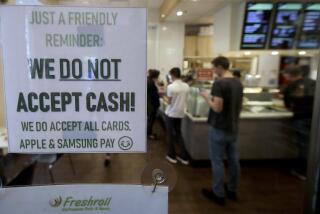Electronic Transfer Plan for Benefits Unveiled : Government: Administration says debit card would deter fraud, reduce costs. Fee may be charged.
- Share via
WASHINGTON — In a step that eventually would eliminate paper welfare checks and food stamps, Vice President Al Gore unveiled a program Tuesday that would allow electronic access to government benefits.
Using a plastic card, similar to an automated teller machine card, welfare recipients and recipients of Social Security disability benefits without bank accounts would be able to walk up to any ATM terminal and withdraw their share of the $500 billion in benefit payments that the federal government doles out annually.
The electronic delivery system, designed as part of the Clinton Administration’s “reinventing government” initiative, is projected to go on-line nationally in 1999. Government officials from nine states--Florida, Alabama, Georgia, North Carolina, South Carolina, Tennessee, Kentucky, Arkansas and Missouri--will start phasing in the electronic transfer plan this year. The system is expected to be operating in those states in 1996.
“This card makes it much easier to deliver the right benefits to the right people with much less paperwork,” Gore said at a ceremony here Tuesday. Appearing with him were Health and Human Services Secretary Donna Shalala, Agriculture Secretary Mike Espy and Texas Comptroller John Sharp, who is overseeing what will be the largest state electronic benefits transfer project when it is fully phased in next year.
Electronic delivery, once fully installed, is expected to reduce the fraud and abuse that plague current assistance programs and simplify labyrinthian federal and state benefits systems, saving taxpayers $195 million annually, Gore said.
With the electronic system, “there’s considerably less paper. The flip side is that we’ll have an electronic audit trail for every transaction, making fraud much easier to detect and prosecute,” Shalala said.
For benefits recipients with bank accounts, having their payments deposited directly is still the most cost-effective means of delivery. But for the estimated 31 million people without bank accounts who are entitled to food stamps, unemployment payments, Social Security payments, Aid to Families With Dependent Children or other benefits, the electronic system will bring convenience and relief from the “stigma” associated with receiving government aid, according to Espy.
Federal and state governments pay $111 billion in military and federal pensions, veterans’ compensation, student loans and general assistance to recipients without bank accounts each year.
In comparison, the annual fund flow for Visa, the nation’s most widely used credit card, approaches $180 billion, the Gore task force said.
Food stamp recipients would swipe the magnetically encoded benefits card through a debit card machine in a grocery store instead of paying for their purchases with paper vouchers. The card would block recipients from buying prohibited products and allow government fraud investigators to track transactions more closely than does the current system. Each card user would have a personal identification number to prevent thieves from using stolen cards.
Printing food stamps--vouchers that grocery shoppers use instead of cash--is wasteful because each voucher can only be used once, Espy said. In some urban areas, food stamp transactions can comprise as much as 40% of a grocery store’s retail food sales, according to the task force. Once the food stamps are collected by grocery stores and shipped back to the Agriculture Department, they are burned.
“The food stamps program we’ve been operating in this country for the last 30 years belongs in the same place the dinosaurs are,” Sharp said. Texas state officials began developing their electronic system to pay veterans’ and other benefits in 1991, he said.
But benefits recipients could be liable for a large chunk of the cost of goods purchased with pilfered cards and could be forced to pay ATM-user fees. Under a current federal law known as Regulation E, a consumer is entitled to reimbursement from his credit card company for all but the first $50 that is fraudulently charged on a stolen card if the theft is reported within two days. Earlier this year, however, the Federal Reserve Board exempted the electronic benefits system from the rule for three years.
Critics fear that the potential fraud losses may bar expansion of the system. Gore’s report says the federal government will work with states and the banking industry to develop strategies to limit exposure to fraudulent claims and distribute the liability among all who have a stake in the new system.
Gore’s plan permits commercial banks to charge welfare recipient fees for each transaction, and represents “a kick in the teeth” to poor people, said Michelle Meier, counsel for government affairs for the Consumers Union, which publishes Consumer Report magazine.
“We are very disappointed that the Administration appears to be laying the groundwork to cut the safety net on poor people,” Meier said.
San Diego County and San Bernadino County officials have submitted a joint plan to adopt an electronic food stamps system but officials in both counties said Regulation E could hamper efforts to establish the system in California.
Still, Southern California grocers, most of whom are equipped with card-swipe machines, have embraced the idea of an electronic benefits system.
“It’s the wave of the future,” said Lynn Titialii, a social services administrator in San Diego.
More to Read
Get the L.A. Times Politics newsletter
Deeply reported insights into legislation, politics and policy from Sacramento, Washington and beyond. In your inbox three times per week.
You may occasionally receive promotional content from the Los Angeles Times.










